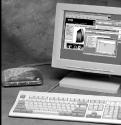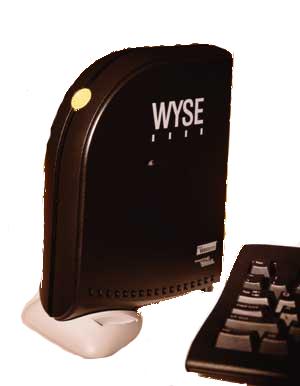LinuxWorld press room runs on… BSD and Windows?
Aug 4, 2004 — by LinuxDevices Staff — from the LinuxDevices Archive — 1 views Wyse contributed BSD-based thin-clients to the press room at LinuxWorld this year. Half-a-dozen of Wyse's tiny 1200LE clients were available for working journalists, who could use them to access the Firefox browser running on a remote Windows server. Things could be different in New York, though.
Wyse contributed BSD-based thin-clients to the press room at LinuxWorld this year. Half-a-dozen of Wyse's tiny 1200LE clients were available for working journalists, who could use them to access the Firefox browser running on a remote Windows server. Things could be different in New York, though.
(Click for larger view of BSD-based Winterm 1200LE)
Where's the Linux?
 Wyse markets thin clients based on Linux, including the just-announced Winterm 5150SE (pictured at right), which it demonstrated at its booth. However, BSD is the OS found on its best-selling thin clients, according to Sr. Product Manager Junaid Qurashi, who explains that the USB-based 1200LE and its legacy port sibling, the 1125LE, now account for about a quarter of the thin-client market leader's sales.
Wyse markets thin clients based on Linux, including the just-announced Winterm 5150SE (pictured at right), which it demonstrated at its booth. However, BSD is the OS found on its best-selling thin clients, according to Sr. Product Manager Junaid Qurashi, who explains that the USB-based 1200LE and its legacy port sibling, the 1125LE, now account for about a quarter of the thin-client market leader's sales.
Qurashi adds that Wyse received the invitation to contribute to the Media Center at the eleventh hour — as part of its Gold Sponsorship of the event — and chose the 1200LE because of its ease-of-setup. “They are truly a server-centric device. They are the easiest client in the industry to install, manage, and bring up,” said Qurashi.
Additionally, a Windows server was already available in the press room: the BSD-based 1200LE is “four or five years old,” according to Qurashi, and can only host Windows applications, either through Citrix's ICA or Microsoft's RDP protocol.
Qurashi adds that Wyse chose the open source Firefox browser for the press room because, “It didn't seem right to have IE at LinuxWorld!”
Big market for a very small client
Remarkably, the 1200LE boots its entire “Blazer” operating system — a heavily modified implementation of BSD, according to Qurashi — from just half a megabyte of Flash. That includes ICA and RDP protocol stacks, Wyse's management client, wireless drivers, PPTP-based VPN software, and remote printing software. “BSD is the only OS that can do that,” says Qurashi.
Wyse's “Wyse Linux,” meanwhile, requires 8MB or 16MB — although, in fairness, it also offers a good deal more functionality, as shown by this comparison chart (80KB PDF download).
As Flash memory technology has advanced in recent years, many smaller-capacity chips have become unavailable, or have become more expensive than larger but more massively produced counterparts. Half-MB chips are still available because they are common in cell phones, but 16MB is the next-smallest commonly available capacity, according to Qurashi.
The price difference between half-MB Flash chips and 16MB Flash chips is probably negligible, at least compared to the current $100 difference between Wyse's $300 BSD-based 1200LE and its $400 Linux-based 5150SE. This suggests an obvious question: will Wyse push Linux down to less expensive price points?
“Way small” Linux client
According to Qurashi, Wyse will announce in September a new Linux-based thin client “much smaller” than even the tiny BSD-based 1200LE.
“I can't say too much about it yet,” said Qurashi, who declined to share a photo of a prototype. He did say that the new device will reach market in November — which makes it ready in time for possible duty in the press room at the January LinuxWorld show in New York (which last year featured a nifty server-centric installation courtesy of Symbio). If so, it will give members of the press an opportunity to run Linux — not Windows — remotely on a tiny Linux-based thin client terminal.
“It's a new, smaller, sleeker Linux platform. It's way small, and way more innovative,” Qurashi added.
We'll keep you posted.
This article was originally published on LinuxDevices.com and has been donated to the open source community by QuinStreet Inc. Please visit LinuxToday.com for up-to-date news and articles about Linux and open source.